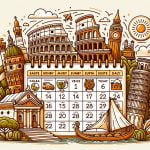When is the best month to travel to Italy? Italy is a must-visit destination for travelers seeking rich history, breathtaking landscapes, and delectable cuisine. From the ancient ruins of Rome to the romantic canals of Venice, there’s something for everyone in this beautiful country.
In this article, we will explore the ideal time to visit Italy based on weather, cultural events, crowds, budget, outdoor activities, cuisine, and local insight. Whether you are drawn to the art and architecture of Florence or the stunning Amalfi Coast, timing your trip to Italy can greatly enhance your overall experience.
Considered one of Europe’s top vacation spots with its diverse attractions from lively cities to picturesque countryside landscapes; each season in Italy offers a unique experience for travelers. The weather and climate vary across different regions in Italy so it’s essential to plan your visit accordingly.
In addition to the weather considerations, festivals and events play a significant role in experiencing Italian culture at its finest. From religious celebrations like Easter and Christmas to renowned events like Carnivale di Venezia and Siena’s Palio horse race; Italy has an array of cultural experiences that may influence your travel plans.
The peak tourist months can greatly impact your travel experience as well – from crowded attractions to soaring prices. Finding a balance between pleasant weather and manageable crowds is crucial for making the most of your trip.Taking into account all these factors will help you determine the best month for a budget-friendly trip without compromising on experiences such as wine tastings or hiking adventures along ancient paths.
Lastly but certainly not least, understanding when local harvests take place can also affect your culinary excursions – enjoying fresh produce during olive or grape harvest seasons adds an extra layer of authenticity and taste to any Italian journey.
Weather and Climate
Italy is known for its diverse climate, offering different experiences depending on the season. Each season has its own charm, making it a fascinating destination to visit all year round. When planning your trip to Italy, it’s essential to consider the weather and climate in order to make the most of your visit.
Spring
Spring in Italy, particularly in April and May, is an ideal time to visit. The weather begins to warm up, and the countryside blooms with colorful flowers. It’s a great time for outdoor activities such as hiking and sightseeing, as well as exploring the beautiful gardens and parks throughout the country.
Summer
Summer is peak tourist season in Italy, with warm weather that is perfect for beach trips along the stunning coastline. However, it’s important to note that many popular destinations can get crowded and hot during this time. If you’re planning to visit Italy in the summer months of June, July, and August, be prepared for higher prices and larger crowds at popular tourist spots.
Fall
Many travelers consider fall as one of the best months to travel to Italy. September through November offers pleasant weather, fewer tourists compared to summer, and the opportunity to experience harvest festivals and food and wine events throughout the country. It’s also a great time for outdoor activities like hiking in the picturesque Italian countryside.
Overall, each season offers unique experiences and opportunities to enjoy everything that Italy has to offer. Depending on your preferences and what you want out of your trip, carefully considering the weather and climate can help you decide when is the best month for you to travel to Italy.
Cultural Festivals and Events
Italy is a country known for its vibrant cultural festivals and events that showcase the rich history and traditions of the Italian people. From elaborate religious ceremonies to lively food and wine festivals, there are countless opportunities to immerse yourself in the Italian way of life throughout the year.
Spring Festivals and Events
Spring is a particularly exciting time to visit Italy, with numerous festivals and events taking place across the country. One of the most famous is Carnevale, which occurs in February or March, depending on the year. This grand celebration features parades, masquerade balls, and colorful costumes, making it an unforgettable experience for visitors of all ages.
Summer Festivals and Events
During the summer months, Italy comes alive with a variety of cultural events, from music and film festivals to historic reenactments. One highlight is the Palio di Siena, a horse race that takes place in July and August in Siena’s main square. This centuries-old tradition showcases the competitive spirit and pageantry of the Italian people.
Autumn Festivals and Events
As the temperatures cool down, Italy’s autumn festivals offer a chance to savor delicious cuisine and wines at harvest festivals throughout various regions. The Salone del Gusto in Turin is a biennial event that celebrates slow food, showcasing traditional Italian dishes made from locally-sourced ingredients.
Overall, no matter what time of year you choose to visit Italy, you are sure to find an exciting festival or event that will provide insight into the country’s diverse cultural heritage. So whether you’re interested in music, food, history or art, there’s always something amazing happening in Italy.
Crowds and Tourist Season
When planning a trip to Italy, it’s essential to consider the peak tourist months and the impact they can have on your travel experience. Understanding when to avoid crowds and long lines can significantly enhance your visit to this beautiful country. Here’s a breakdown of the peak tourist months in Italy and their impact.
1. June-August: These summer months are considered peak tourist season in Italy. The weather is warm, and many attractions and beaches are bustling with visitors. This translates to longer wait times at popular landmarks and higher prices for accommodations and tours.
2. April-May and September-October: These shoulder seasons offer a good balance between favorable weather and manageable crowds. Spring (April-May) brings blooming flowers and pleasant temperatures, while autumn (September-October) features mild weather and colorful foliage. Visitors can expect smaller crowds compared to summer, making it easier to explore attractions without feeling overwhelmed.
3. November-March: Winter in Italy sees a decrease in tourist numbers, especially in cities like Rome, Florence, and Venice. While some attractions may have reduced hours or be closed for renovation during this time, winter allows for a more laid-back experience where visitors can immerse themselves in local life without competing with throngs of tourists.
Understanding the impact of peak tourist months on your travel experience allows you to make informed decisions when planning your trip to Italy. Whether you prefer to embrace the energy of high season or savor a more relaxed atmosphere during the shoulder seasons or winter, knowing when to visit can greatly enhance your Italian adventure.
Budget and Cost
Italy is a destination that offers something for every traveler, from stunning historical landmarks to delicious cuisine and beautiful landscapes. When planning a trip to Italy, it’s important to consider your budget and the cost of travel. Choosing the right month to visit can make a significant difference in terms of affordability.
If you’re looking for the best month to travel to Italy on a budget, consider visiting during the shoulder seasons of spring (April-May) or fall (September-October). During these months, you can enjoy pleasant weather, fewer crowds, and lower prices on accommodation and airfare compared to the peak summer months. Additionally, you’ll still be able to experience many cultural events and festivals during these times.
In terms of budget-friendly activities, visiting Italy in the shoulder seasons allows you to take advantage of outdoor activities such as hiking and sightseeing without the scorching heat or peak season prices. You can also explore local markets and enjoy delicious Italian cuisine at more affordable prices. Overall, traveling during the shoulder seasons can help you save money while still experiencing the beauty and culture of Italy.
| Best Month for Budget-Friendly Travel | Shoulder Seasons: Spring (April-May) or Fall (September-October) |
|---|---|
| Affordable Accommodation | Lodging costs are lower compared to peak summer months |
| Budget-Friendly Activities | Enjoy outdoor activities and dining at more affordable prices |
| Savings on Airfare | Lower prices on flights during shoulder seasons |
Outdoor Activities
When it comes to outdoor activities, Italy offers a diverse range of options for travelers. Whether you are interested in hiking through the picturesque countryside, relaxing on beautiful beaches, or taking in the sights and sounds of historic cities, there is no shortage of opportunities to explore the great outdoors in Italy.
To make the most of your outdoor adventures in Italy, it’s important to consider the best times to visit for each activity. Here’s a guide to help you plan your trip:
- Hiking: The best months for hiking in Italy are typically spring (April and May) and autumn (September and October). During these times, the weather is mild, and the landscapes are at their most vibrant. Not only will you be able to enjoy comfortable temperatures, but you’ll also have the chance to witness blooming wildflowers or colorful autumn foliage depending on the season.
- Beach Trips: If you’re looking to soak up the sun and relax on Italy’s stunning beaches, then the best time to visit is during the summer months of June, July, and August. During this time, you can expect warm temperatures perfect for swimming and sunbathing. Keep in mind that popular beach destinations tend to be crowded during this peak tourist season.
- Sightseeing: For those interested in sightseeing and exploring Italy’s iconic landmarks and historical sites, the shoulder seasons of spring and autumn are ideal. The weather is still pleasant enough for walking tours and outdoor excursions while avoiding the large crowds that flock to popular attractions during the summer months.
By planning your outdoor activities around these optimal months, you can make sure that you get the most out of your travel experience in Italy while taking advantage of favorable weather conditions for each activity.
Cuisine and Wine
Italy is famous for its delicious cuisine and world-renowned wines, making it a must-visit destination for food and wine enthusiasts. The best months to experience the rich culinary scene in Italy are during the harvest season, which typically takes place from September to October. During this time, visitors can participate in grape and olive harvests, as well as indulge in food and wine festivals that showcase the best of Italian gastronomy.
One of the most popular food festivals in Italy is the truffle festival, which typically takes place in various regions such as Piedmont, Tuscany, and Umbria from late September to early December. This is the perfect opportunity for travelers to savor dishes made with fresh truffles while also enjoying local wines and culinary demonstrations. Additionally, October is an ideal month to visit Italy for wine enthusiasts, as it marks the beginning of the grape harvest in many wine-producing regions.
In addition to food and wine festivals, visitors can also experience authentic Italian cuisine by partaking in cooking classes and farm-to-table dining experiences throughout the country. These activities provide insight into traditional Italian cooking methods and allow travelers to taste fresh, locally sourced ingredients at their peak ripeness. Overall, if you are a fan of Italian cuisine and wine, visiting Italy during the harvest season from September to October is highly recommended.
| Food Festival | Month |
|---|---|
| Truffle Festival | Late September – Early December |
| Grape Harvest | October |
Local Insight
Italy is a country that offers something for everyone, from its rich history and culture to its delicious cuisine and stunning landscapes. Whether you are interested in exploring ancient ruins, indulging in world-class cuisine, or simply basking in the Mediterranean sun, Italy has it all. With so much to offer, it’s no wonder that many travelers often wonder when is the best month to travel to Italy.
Many locals will tell you that May and September are the best months to experience authentic Italian culture and hospitality. During these months, the weather is mild, the crowds are thinner, and there are numerous festivals and events where you can immerse yourself in Italian traditions. Additionally, these shoulder seasons offer budget-friendly options for accommodations and attractions while still providing a genuine Italian experience.
In conclusion, while each season in Italy has its own unique appeal, local insights suggest that May and September are the ideal months for experiencing authentic Italian culture and hospitality. By visiting during these months, you can enjoy pleasant weather, cultural festivities, budget-friendly options, and a closer connection with the locals.
So if you’re planning a trip to Italy and wondering when is the best month to travel to Italy, consider heeding the advice of the locals and plan your visit for May or September for an unforgettable Italian experience.
Frequently Asked Questions
What Month Is the Best Weather in Italy?
The best weather in Italy is usually during the late spring and early fall months. Months like May, June, September, and October tend to have milder temperatures and less rainfall, making it ideal for outdoor activities and sightseeing.
What Is the Cheapest Month to Go to Italy?
The cheapest month to go to Italy is typically November. This is when the tourist season has slowed down, and prices for accommodations and flights tend to be lower. It’s also a great time to experience Italy with fewer crowds.
What Month Has the Least Tourists in Italy?
January is often considered the month with the least tourists in Italy. After the holiday season, many tourists have returned home, leaving popular tourist destinations less crowded. This allows visitors to explore without the hustle and bustle of peak tourist season.

I’m a passionate traveler, writer, and Italophile. My fascination with Italy’s history, art, and culture has led me on countless adventures across the Italian landscape. Through “I Live Italy,” I share my love for this extraordinary country and aims to inspire others to explore its boundless beauty.





